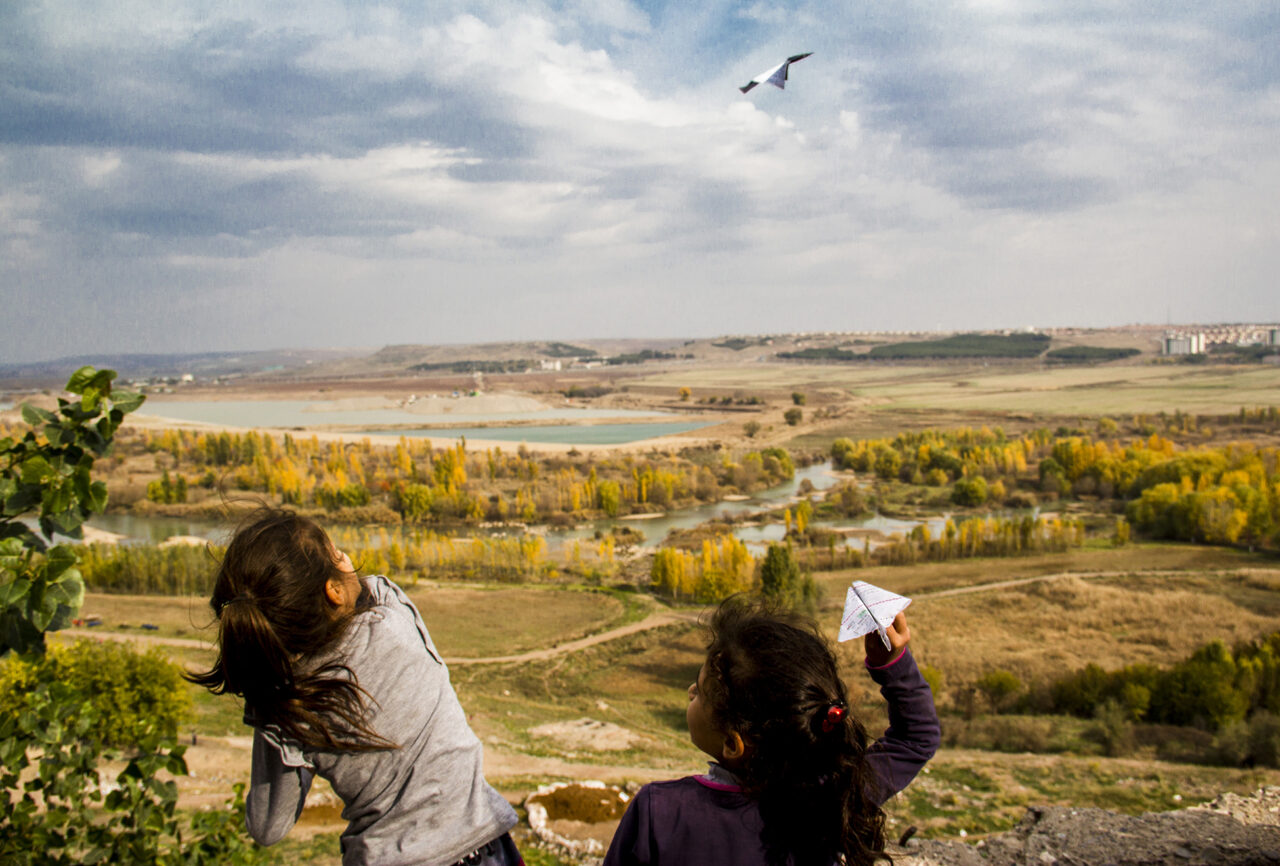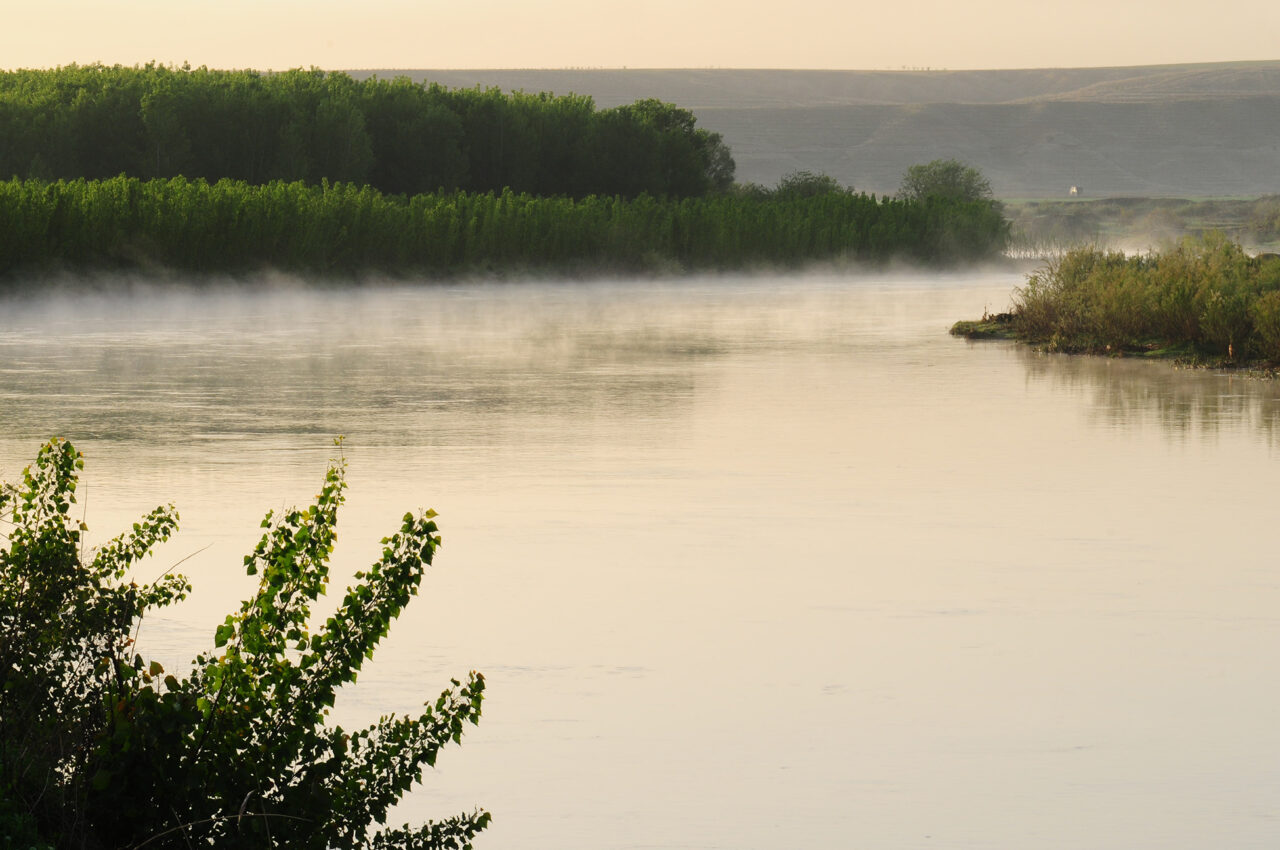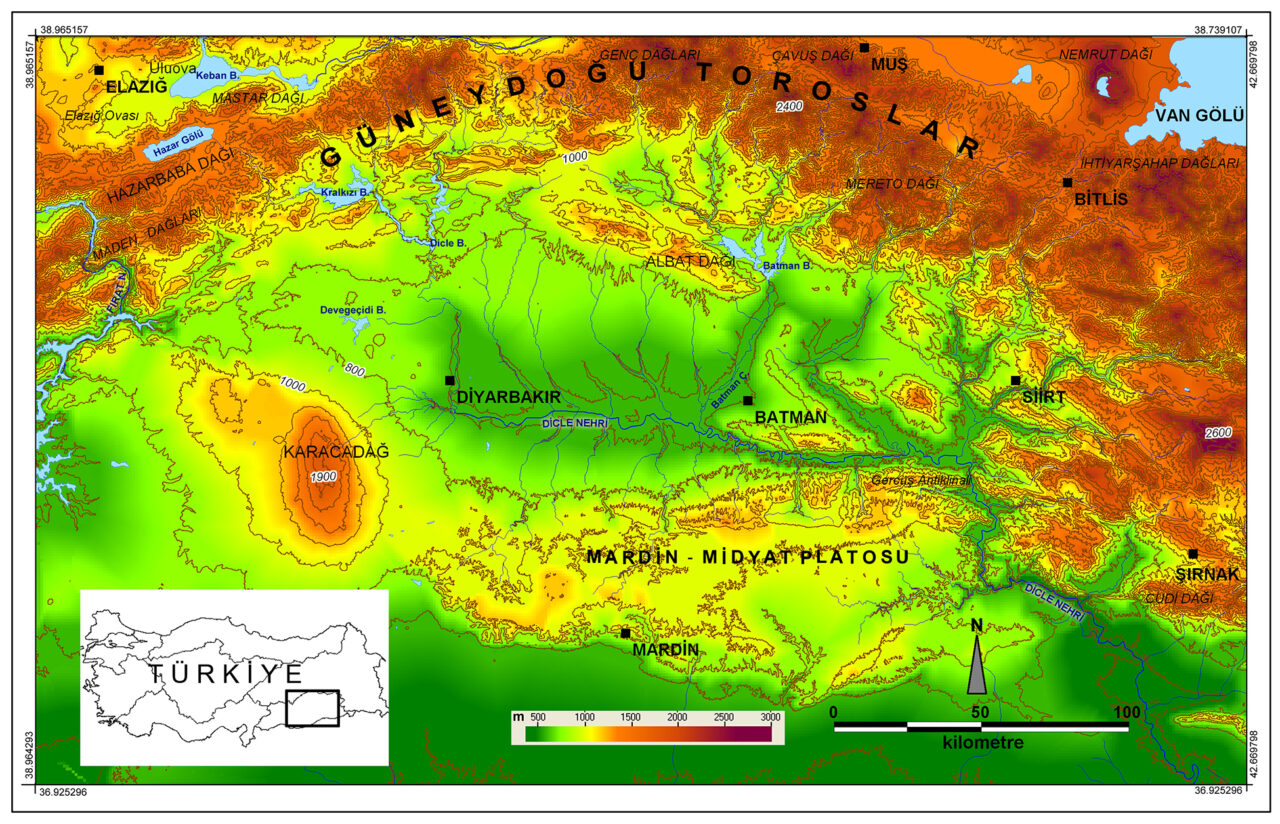
In terms of its geographical location, geographical formations and climate, Diyarbakır is located in a transition zone. The basin the city is located in reflects all natural environment changes that took place in the region through geological eras, and for this reason, has unique features in many aspects.
Under the influence of both terrestrial and wetland ecosystems with many of their sub-groups, the Diyarbakır Basin possesses great diversity in terms of both fauna and flora. With the added influence of non-geographical elements, the basin has been an attractive habitat for humanity in all periods of history. The natural environment has had a direct impact on demographic structure, settlement types and economic activities, thus shaping social structure.
This special topography was examined by Sabri Karadoğan, an academic staff member at Dicle University, Ziya Gökalp Faculty of Education, Department of Geography Education. Hydrobiologist Erhan Ünlü focused on the region via the Tigris River. Finally, urban and regional planner Zeki Fırat Yıldırım drew attention to the process that led to the Tigris River’s demotion to the status of “stream” and its consequences.
The Diyarbakır Basin comprises the planes between the fold belt of the South-eastern Toros mountains (the Silvan-Hazro fold belt) in the north and the east, and the Mardin Plateau in the south in the Tigris section of the South-eastern Anatolian Region.
The Diyarbakır Basin is located on the belt that forms the folded mountain chain in the southern most area of Turkey, and is located in a transition zone both in terms of climate and geographical formations. Its geographical position has intensely experienced the natural environment changes that took place through the geographical eras.
Basalt flows, on which the city of Diyarbakır is also founded, which reach the Tigris River and are interrupted by it, are a unique topographical feature of the region. In the area where the old city was founded, we see that steep slopes have emerged as a result of basalt blocks encountering clay deposits and the erosive impact of the Tigris River. Interrupted by the Tigris River, steep basalt cliffs led to the formation of a space suitable for defence purposes. Basalt rock is a suitable material both for building city walls, residential buildings and other architectural structures.
Prof. Dr. Sabri Karadoğan, Faculty Member at Dicle University, Ziya Gökalp Faculty of Education, Department of Geography Education


We can describe the Diyarbakır Basin as a broad sedimentation zone featuring significant topographic thresholds, with the South-eastern Toros Mountains to the north, the high Mardin-Midyat limestone plateau to the south, the Karacadağ Volcano to the west and Raman Mountain to the east.
The geomorphological evolution of the Diyarbakır Basin clearly reflects both crustal movements and topographic erosion processes following continental collision and the closing of the Southern Neo-Tethys Ocean. The basin formed, especially due to geomorphological processes, a more suitable habitat in comparison to its close vicinity in the topographic sense and with the added impact of other favourable geographical factors such as transportation, land, hydrography, underground and overland sources, its attraction increased. Although summer drought and conditions of severe evaporation pose challenges, the basin is rich in terms of its water potential. Precipitation in its high surroundings gravitate towards the centre of the basin via subterranean waters or the tributaries of Tigris River.
Sabri Karadoğan
Despite the Diyarbakır Basin presenting a typical basin character in the hydrographical, geological and geomorphological sense, the Tigris River and its tributaries are entrenched in the terrain in almost every section of the basin. In other words, the Diyarbakır Basin is a zone of low and high plateaus. Since this removes the risk of flooding from rivers that would interrupt the development of their alluvial deposit and land, the basin surface possesses first class agricultural land.
The composition of natural environment that changed throughout history is also reflected in the diversity of fauna and flora. Thus, we are able to speak of a biological diversity that comprises European-Siberian, Mediterranean and steppic fauna and flora elements. Terrestrial and wetland ecosystems are represented with many sub-habitat types. Within the wetland ecosystem, there are many sub-systems including rivers and streams with high current velocity, sluggish and slow flowing rivers and karst lakes. Within the terrestrial ecosystem on the other hand, there are many habitats including steppes, oak forests, orchards, rivers, valleys, mountains and volcanic zone ecosystems.
Sabri Karadoğan


The Diyarbakır Basin is a unique geographical area in terms of its physical qualities. This means that both with its geological and geomorphological and also its climatic qualities, it plays a key role in the illumination of many geographical problems in Turkey. The same geographical totality and variegation is displayed in the areas of demographics, settlement and economic activities. Especially in terms of its rural population and social organization around aşiret [tribes], we can speak of a different social structure when compared to other geographical regions in Turkey.
The Diyarbakır Basin is a zone where physical conditions have undergone a rapid change and development, which includes subzones of different origins at close proximity and also where the heterogeneous cultural structure constantly changes and flourishes. Throughout history, the basin has presented suitable physical conditions both for nomadic and sedentary life.
Since the morphological structure of areas to the north is arduous, challenging and mountainous, the Tigris River flows through straits. The steep rocks and calcareous blocks in the vicinity presented an ideal environment for civilizations seeking defence, while the fertile soil formed with the alluvial deposit of the Tigris River which further down flows within a plateau by cutting through the land, the constantly expanding valley followed by plains that are an extension of the Arabian platform, acted as host to early sedentary order and the development of agriculture in human history. Suitable climate and transportation conditions also had a strong impact on this. After all, the region is part of the “fertile crescent” and Upper Mesopotamia, and possesses far more suitable conditions compared to the arid or semi-arid plains to its south.
The region is important in terms of the history of civilisation not only as part of Mesopotamia, but also as a site where Near Eastern and Anatolian cultures met and merged. It is thus possible to come across many archaeological remains that bear witness to the cultural richness of many millennia across the basin. Countless tumuli including Çayönü, Körtik Tepe, Salat Tepe, Üçtepe, Ziyaret Tepe and Hallan Çemi and ancient settlements such as Hassuni, Hilar, Eğil and Zerzevan Castle are considered core settlements that shed light on the history of humanity.
Sabri Karadoğan
The young fold mountain belts to the north of the region are of universal significance. Especially the morphological structure of Gercüş, Hacertun (Hazro), Çermik and their environment are geological formations rarely encountered across the earth. Traces of the Arabian-Anatolian continental collision that led to the formation of the entire South-eastern Toros mountain range and also triggers the Anatolian plate can prominently be observed along with the South-eastern Anatolian tectonic overthrust. The edge-folds and southern terrain also form the most significant oil reserve belt of the country.
As it was in the early Holocene, or the second part of the Fourth Epoch, today, too, the area is in a belt which is active and variable in terms of climate. While the floor of the basin experiences the most arid and warmest climatic conditions in Turkey, in the skirts of the northern fold and along the Mardin-Midyat threshold to the south, relatively wet and humid climatic conditions prevail. The floor of the basin is one of the most important fluvial sediment environments in Turkey. Particularly the terrace sets, tens of kilometre long and hundreds of metre wide, located around the Tigris River, are worth investigating in terms of the geomorphology of the Fourth Epoch.
Sabri Karadoğan

The Mardin Plain forms an interesting geographical composition, in the natural sense, with its karst formations shaped by the dissolution of limestone, but also in a way that leaves its imprint on human life. Valleys along the plain such as Sürgücü, Savur, Şeyhan, Beyaz Su and Gurs are each a microclimate zone and also include Turkey’s oldest land formed in the Primary Era, featuring rare fossil types like Trilobites.
The Karacadağ area, Turkey’s widest volcanic formation around the only volcano formed as a result of a Hawaiian type eruption features unique qualities in terms of its character and impact. With its basalt plateau, lava flows, valleys and columns and the miniature volcanic cones around it that form a geopark means that the Karacadağ volcanic zone is among Turkey’s and the region’s unique geological sites. The geographical impact of the Karacadağ Volcano is reflected in social life, economic activities, life styles and as seen in Diyarbakır’s centre within its walls, to the settlement texture and architecture, to a surprising extent.
Sabri Karadoğan
Throughout history, humankind has lived close to wetlands where it was easiest to access food, and this was where the first civilisations were founded. Such locations cannot be perceived only as areas of food storage, they are also strategically important areas. Like many rivers, the Tigris River, too, forms rich ecosystems formed of microorganisms, plants and animals.
The Tigris River flows south from the South-eastern Toros Mountains, meanders across the plains of the Diyarbakır plateau, eventually forming the Hevsel Gardens, a table of cornucopia enriched by alluvia in the east and south of the Diyarbakır walls. The geomorphological regime changes along the Tigris Valley create sensitive ecosystems. Marshes, sediments, lagoons, islets and reed-beds formed here are all rich ecological habitats.
Prof. Dr. Erhan Ünlü, Hydrobiologist


The tumulus discovered in the acropolis of the fortified city tells us that the settlement history of the city of Diyarbakır goes as far back as the 4th millennium BC. The Hevsel Gardens, too are an important part of everyday life and social and economic structure that provide Diyarbakır with plentiful products, host many historically significant cultural values and develop the city’s social and cultural life.
The Tigris River displays, in parts, a trellis river pattern depending on the angle conditions as it flows through the broad valley around the city, and forms sand dunes. These dunes are close to underground waters, and are made up of aerated sandy soil. This is also the place where the gargantuan Diyarbakır watermelons are grown.
Erhan Ünlü
In the year 2015, the Diyarbakır City Walls and the Hevsel Gardens were included on the UNESCO World Cultural Heritage List. However, as a study of the subject reveals, the knowledge and awareness of local bodies regarding the inclusion of Diyarbakır Castle and Hevsel Gardens on the list is not at an adequate level.¹
Sometimes softly flowing and roaring at other times, the Tigris River is an important river not only of the Middle East but of the entire Asian continent. The Hevsel Gardens, formed with the alluvia brought by the Tigris River from the Toros Mountains and plains, for millennia, provided plenty of produce to the peoples living under the Amed city walls and also served as home to rare plants and species of animals. In the past, in its bright blue waters, fish lived, while in the reed-beds and backwaters along the river frogs, turtles, water snakes, birds and otters lived freely and fearlessly. However today, because of various human interventions and pollution, the bright blue waters have been muddled; the reed-beds and sand dunes have been damaged. Mass fish deaths are frequently observed. This constitutes the greatest evil that can be done to future generations.
Erhan Ünlü
¹ Zehra Çağlar, UNESCO Dünya Miras listelerinin turizme etkisi: Diyarbakır Surları ve Hevsel Bahçeleri örneği [The Impact on Tourism of UNESCO World Heritage Lists: The Example of Diyarbakır City Walls and the Hevsel Gardens], Batman University, 2018.


Unfortunately, today, the diversity of life in the Tigris River and its environs is decreasing because of construction development and the building of dams, thus the site where production historically began is rapidly heading towards exhaustion.
In listing factors that have had an impact in this process, we must perhaps begin with the fact that the Tigris River does not even have river status within the borders of Diyarbakır. The flow-rate of the river has decreased because of the dams that have been built on it. As a result of this, the part of the river from its source until the Bismil district of Diyarbakır has been demoted to “stream” status. In this way, one of the best known rivers in history has been transformed into a river.
Yet when we look at the etymology of the Tigris River, we first encounter the Sumerian word İdigna, which means “running water”. This word then became İdiklat in Akkadian and Diklat in Assyrian. Diklat then became Dicla in Arabic, Dicle in Turkish and Dîjle in Kurdish.
The name of the river known worldwide is Tigris. According to the famous ancient historian and geographer Strabo, it was the Medes and the Achaemenids that gave the river the name Tigra, meaning “arrow”. The language of the Medes is considered early period Kurdish, while the language of the Achaemenids is considered early period Persian. Tigris also means “tiger” in many languages, an agile animal itself often likened to an arrow.
In the light of this information, the current situation of the Tigris River, known throughout history as a swiftly flowing river, is particularly upsetting. This new status of the river means that buildings can be constructed at a distance of 50 metres from its shoreline.
Zeki Fırat Yıldırım, Urban and regional planner
Translation: Nazım Dikbaş
BIBLIOGRAPHY
Sabri Karadoğan
• Ardos, M. (1992) Türkiye’de Kuvaterner Jeomorfolojisi [Turkey’s Quaternary Geomorphology], İstanbul Üniversitesi Edebiyat Fakültesi Yayını, Istanbul.
• Atalay, İ. (1987) Türkiye Jeomorfolojisine Giriş [An Introduction to Turkey’s Geomorphology], Ege Üniversitesi Edebiyat Fakültesi Yayını, İzmir: 384.
• Erinç, S. (1980) “Kültürel Çevrebilim Açısından Güneydoğu Anadolu [Southeastern Anatolia in terms of Cultural Ecology]”, Istanbul and Chicago Universities’ Joint Prehistoric Research Project in Southeastern Anatolia, (ed.) H. Çambel and R. J. Braidwood, İstanbul Üniversitesi Edebiyat Fakültesi Yayını, Istanbul: 65-72.
• Haksal, A. (1981) Petrographie und Geochemie des Schildvulkans Karacadağ, unpublished doctoral thesis, Universität Hamburg, Hamburg.
• Karadoğan, S. and Kozbe, G. (2013) “Yukarı Dicle Havzasının (Batman-Bismil Arası) Jeomorfolojik Özellikleri ve Arkeolojik Yerleşme/Buluntu Yerlerinin Dönemler Boyunca Mekan Etkileşimleri [Geomorphological Characteristics of the Upper Tigris Basin and Spatial Interactions throughout the Periods of Archaeological Settlements/Discovery Sites]”, Profesör Doktor İlhan Kayan’a Armağan, (ed.) Ertuğ Öner, Ege Üniversitesi Edebiyat Fakültesi Yayını, İzmir: 540-564.
• Karadoğan, S. (2019). “Kuruluş yeri açısından Diyarbakır kentinin sitüasyonu ve jeoloji-jeomorfoloji ilişkileri [The situation of the city of Diyarbakır in terms of its site of foundation and geological-geomorphological relations]”, Uluslararası Katılımlı 72. Türkiye Jeoloji Kurultayı Bildiriler Kitabı, Jeoloji Mühendisleri Odası Yayınları, Ankara: 890-895.
• Sözer, A.N. (1984) “Güneydoğu Anadolu’nun Doğal Çevre Şartlarına Coğrafi Bir Bakış [A Geographical View of the Natural Environmental Conditions of Southeastern Anatolia]”, Ege Coğrafya Dergisi, 2(1): 8-30.
• Şaroğlu, F. (1986) “Doğu Anadolu’nun Neotektonik Dönemde Jeolojik ve Yapısal Evrimi [The Geological and Structural Evolution of Eastern Anatolia in the Neotectonic Period]”, Maden Tetkik ve Arama Dergisi, 107: 70-93.
• Yıldırım, A. and Karadoğan, S. (2010) Güneydoğu Anadolu’nun Jeo-Tektoniği ve Depremselliği [The Geotectonics and Seismicity of Southeastern Anatolia], Çantay Yayınları, İstanbul.
Erhan Ünlü
• Baştuğ, İ. (2014) “Cennet Bahçesi Hevsel [Hevsel, Garden of Paradise]”, Atlas, 254.
• Çağlar, Z. (2018) UNESCO Dünya Miras listelerinin turizme etkisi: Diyarbakır Surları ve Hevsel Bahçeleri örneği [Impact of UNESCO World Heritage lists on tourism: The example of Diyarbakır City Walls and Hevsel Gardens], unpublished Master’s Thesis, Batman University, Batman.
• Ökse, A. T., Soyukaya, N., Yumruk, Ş., Doğan, N., Ayçiçek, G., Akdemir, N. A., Akmaz, M. S., Akkuş, E., Han, Z. and Humartas, S. (2015) “The Earliest Settlement of the City of Diyarbakır: Amida Höyük at İçkale”, OLBA, 23: 59-110.
• UNESCO (2015): “Diyarbakır Fortress and Hevsel Gardens Cultural Landscape”, UNESCO World Heritage List, 2015.
With thanks to: I owe a debt of gratitude to Prof. Dr. Sabri Karadoğan, archaeologist Nevin Soyukaya and Atlas magazine (for geographical, historical and archaeological information) and to many other scientists I cannot name here for their contributions. – Erhan Ünlü
Zeki Fırat Yıldırım
• Aksoy, B. (2000) “Dicle Adının Kaynağı [The Source of the Name ‘Dicle’]”, bilalaksoy.com.
• Ayman, O. (2011) “Dicle Güzeli [The Beauty of Dicle]”, National Geographic, 28.
• “Dicle Nehri’ne ranta açabilmek için ‘dere’ statüsü [Tigris River demoted to ‘stream’ for profit]”, Kuzey Ormanları Savunması, 2015.
• Doğan, K. F. (2011) “Dicle’nin etimolojisi üzerine deneme [An essay on the etymology of Dicle]”, cebaxcor.blogspot.com.
• Ertekin, A. S., Dicle Vadisi Florası [The Flora of the Dicle Valley].
• Mungan, R. (2010) Buğdaycıl’ın (Luscinia Svecica) Dicle Kuş Halkalama İstasyonundaki (Diyarbakır) Göç Dinamiği [The Migration Dynamics of Luscinia Svecica at the Dicle Bird Banding Station (Diyarbakır)], Master’s Thesis, Dicle University Institute of Science, Diyarbakır.
• Ünlü, E., Dicle Nehri’ndeki Biyolojik Yaşamı Tehdit Eden Çevresel Faktörler [Environmental Factors Threatening Biological Life in the Tigris River].



